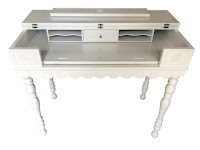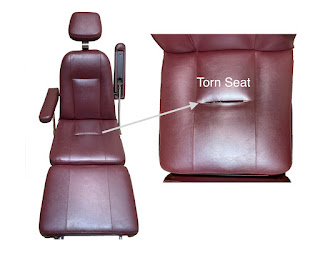 |
| Eastlake Chair After |
 |
| Eastlake Chair Before |
After I removed the old fabric, as I had guessed, the foam was so deteriorated it resembled a dried out loaf of bread. Yellow dust had sifted out of the chair’s bottom edges as I pried the old fabric off. It was indeed a mess and was simply not usable in its condition. Once I removed all the fabric, I made yet another discovery. The springs were tied to the chair upside-down, meaning they were strung to the bottom of the chair instead of the top of the chair’s seat, as it should have been done. This involved removing all the “guts” of the seat, which was the old deteriorated webbing as well as the springs and strings.
Plus instead of using webbing to secure the springs to, they had used burlap only, which was definitely inadequate. Webbing is attached to the bottom of the chair then the springs are attached to the webbing. After this step, the springs are tied in the “eight-way” tying technique so that they are secure and do not move as well as adding the proper support and structure to the seat. Retying strings is a time-consuming job and requires accuracy and a bit of upper body work, or they won’t hold up for the long haul. I tend to over-tie springs, erring on the side of extra instead of under-tying them. Better more than less in this application.
 |
| New Webbing With Springs Ready for Tying |
Once I had the cotton in place, I stapled a layer of high quality muslin to cover everything else I had applied. The muslin makes a nice final surface on which to attach the fabric. Because my customer was on a tight budget and didn’t want to purchase new fabric, I chose a soft gray plush material, which was left over from a previous job, and was just enough to complete this chair.
The cushion on the arms needed to be replaced as they too were beyond usage. I used the old cushions as templates and cut new ones using my carving knife. It worked quite well and covered the area nicely. The back of the chair needed new webbing and foam. The fabric was applied to both front and back of the upper part of the chair and the entire chair was finished with piping, which I prefer to using decorative nail heads which are difficult to pound into hardwood, such as this. I polished the metal wheels, which were original to the chair. The chair was once again usable.


































